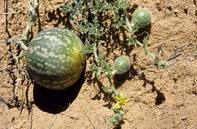Kalahari melon oil or Citrullus lanatus is also known as watermelon seed oil. Other names for this indigenous Southern African fruit are karkoer, mankataan, tshamma, ootanga or wild watermelon.

A relative of the watermelon, the Kalahari melon is found in the arid Kalahari region of southern Africa.
The oil is extracted by crushing the seeds after drying. The creeping plant with its yellow flowers grows well in low-fertility, sandy soils and is drought resistant and hardy and can be valuable as an intercrop plant providing soil cover to reduce erosion and water loss.
Benefits of Kalahari Melon Oil
Kalahari melon fruit is used by the San (Bushmen) people as a source of water, as well as a moisturiser and sunscreen. It is eaten by livestock and game. As a human food source, the seeds are high in protein (35%) and can be roasted, eaten or ground up as a porridge.
The Kalahari melon fruit is round (growing wild) or oval (cultivated) and is light green with darker green mottled stripes. The seeds produce a rich yellow oil, used in cosmetics to promote hair growth, as well as an ingredient in soap.
Grounded Kalahari melon seeds are employed as an exfoliant. Kalahari melon seed oil has similar levels of omega-6 essential fatty acid (68%) to evening primrose (72%), assuring anti-inflammatory properties, restoring skin elasticity and combating wrinkles. It is a good baby oil and can be used as a carrier oil.
Medical Disclaimer
Information is for educational and informational purposes only and may not be construed as medical advice. The information is not intended to replace medical advice or treatment offered by healthcare professionals.
By Marinda Louw
For bulk or Kalahari Melon Oil export enquiries please use the enquiry link below.